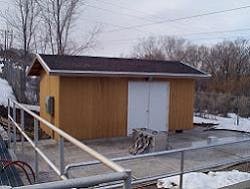In recent years, there has been a significant increase in the number of municipalities utilizing ultraviolet technology (UV) as a means for disinfecting municipal drinking water and wastewater. The more traditional method of disinfection by chlorination has been superseded by the overwhelming benefits of UV.
In February of 2004, the American Falls (Idaho) WWTP commissioned a WEDECO TAK UV system for the disinfection of municipal wastewater. UV was chosen as a replacement of the existing chlorination process. Based on specification work by Keller Associates, Inc., the UV system was designed for the following water quality characteristics:
| Peak disinfection flow rate | 1.0 mgd |
| Average disinfection flow rate | 0.5 mgd |
| Total Suspended Solids (TSS) | less than 30 mg/l |
| BOD5 | less than 30 mg/l |
| Minimum UV transmittance | 60% |
Perhaps the most critical component in the design of any UV system is the UV dosage delivered to the effluent, calculated as follows:
Dose = UV Intensity X Retention Time
UV intensity describes the output of the UV lamps (or more specifically the UV-C output of the lamps at 254nm—the optimum wavelength for UV disinfection), which is heavily influenced by the water quality characteristics mentioned above. Retention time represents the length of time the effluent is exposed to the UV light as it passes through the system. Given an effluent E. Coli discharge standard of <126 MPN per 100 mL (based on a 30-day geometric mean), the WEDECO system for the American Falls, WWTP was designed to deliver a minimum UV dose of 85 mJ/cm2.
Achieve requirements
To achieve the specified disinfection requirements for the American Falls WWTP, the UV system was designed to employ 48 UV lamps arranged in a series of two UV banks within one open concrete channel formed as part of the reconstruction of the existing chlorine contact chamber. Each bank is made up of 24 UV lamps, where disinfection can be accomplished with one UV bank of lamps in service and the second UV bank acting as standby—thereby providing for 100% system redundancy. Effluent level control through the system is maintained by use of a fixed weir positioned at the discharge end of the channel.
The system also employs a pneumatically actuated wiping system that is fully automatic and chemical-free. It prevents formation of organic and inorganic deposits on the quartz sleeves and is fully operator adjustable via the system PLC. The system ensures disinfection performance is met at all times by monitoring and maintaining the specified dosage. Changes in effluent characteristics, flow rates, and UV-C lamp intensity are continuously monitored, and the system is automatically adjusted via the dose pacing controls to guarantee disinfection.
As a replacement for chlorination processes, UV disinfection helps to eliminate the introduction of potentially dangerous chemicals such as chlorine to our water systems. The American Falls (Idaho) WWTP is yet another example illustrating the environmental advantages of UV as a means of disinfection for applications in the municipal market.
